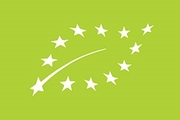Productiesysteem
Rekening houden met de milieuvoordelen van labels
Producten met een label krijgen een bonus die varieert van 10 tot 20 punten, afhankelijk van de mate van betrokkenheid en de geschatte milieuvoordelen die zij vertegenwoordigen. Het niveau van het voordeel wordt bepaald op basis van de tot op heden beschikbare wetenschappelijke literatuur: LCA, klimaatveranderingsindicatoren, fytosanitaire behandelingen, eutrofiëring, gevolgen voor de biodiversiteit, koolstofopslag in de bodem, gevolgen voor ontbossing, enz. (zie bronnen).
Groep 1: +20 punten
 Nature & Progrès — http://www.natureetprogres.org
Nature & Progrès — http://www.natureetprogres.org Bio Cohérence — http://www.biocoherence.fr
Bio Cohérence — http://www.biocoherence.fr Demeter — https://www.demeter.fr
Demeter — https://www.demeter.fr
Groep 2: +15 punten
 AB Agriculture Biologique — http://www.agencebio.org
AB Agriculture Biologique — http://www.agencebio.org Technique de pêche durable¹
Technique de pêche durable¹
Groep 3: +10 punten
 UTZ — https://utz.org
UTZ — https://utz.org Rainforest Alliance — https://www.rainforest-alliance.org
Rainforest Alliance — https://www.rainforest-alliance.org Fairtrade — http://www.fairtrade.net
Fairtrade — http://www.fairtrade.net Label Rouge — https://www.labelrouge.fr/
Label Rouge — https://www.labelrouge.fr/ ASC — http://www.asc-aqua.org
ASC — http://www.asc-aqua.org MSC — http://www.msc.org
MSC — http://www.msc.org
The Label Rouge bonus only applies to certain meats: beef, veal, lamb.
Bronnen
¹ Sustainable fishing techniques: line and hook, rod fishing, trap, shore fishing. These methods are selective and have no impact on the seabed and the habitat.
ADEME. (2020). Environmental labels. https://www.ademe.fr/labels-environnementaux
PUSH. (2020). Evaluation of food labels. https://www.labelinfo.ch/fr/projets-devaluation/-evaluation-des-labels-alimentaires
ITAB & INRA. (2016, novembre). Quantify and cost economically the externalities of organic farming ? http://itab.asso.fr/downloads/amenites/amenites-ab-synthese-nov2016.pdf
Réseau Action Climat & Fondation pour la Nature et l’Homme. (2010, septembre). Agriculture and greenhouse gases: state of the art and prospective. https://www.fondation-nicolas-hulot.org/wp-content/uploads/2020/10/101110_agriculture_et_gaz_a_effet_de_serre-etat_des_lieux_et_perspectives.pdf
Association Bleu-Blanc-Cœur. (2019, septembre). Assessment of the environmental impact of products in the Bleu-Blanc-Cœur sector by Life Cycle Analysis (LCA) - Methodological report.
WWF. (2019). Meat: eat less, eat better. https://www.wwf.fr/sites/default/files/doc-2020-11/MAJ202011_Etude_Viande-manger-moins-manger-mieux_WWF.pdf
France Stratégie. (2020, aout). The economic and environmental performance of agroecology. https://www.strategie.gouv.fr/sites/strategie.gouv.fr/files/atoms/files/fs-2020-na-94-agroecologie-aout.pdf
Last updated

